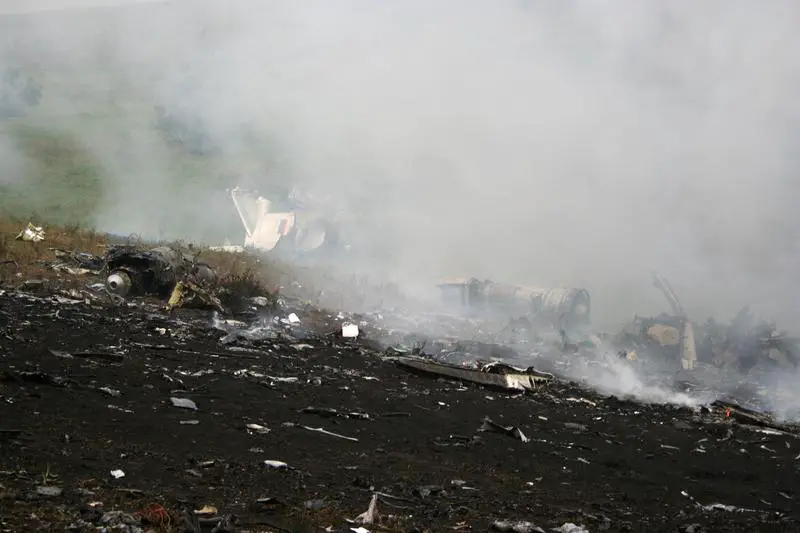All 49 people aboard an Angara Airlines passenger flight died Thursday, July 24, 2025, when their Soviet-era aircraft crashed in Russia’s remote Amur region while attempting to land for a second time during poor weather conditions.
The Antonov An-24 aircraft disappeared from radar screens at approximately 1 p.m. local time while approaching Tynda airport, about 4,350 miles east of Moscow. The flight had departed from Khabarovsk before stopping in Blagoveshchensk on the Russian-Chinese border and continuing to its final destination of Tynda, a remote town and important railway junction in the Amur region.
Search and rescue teams discovered the burning wreckage on a mountainside approximately 10 miles south of Tynda airport. Russian Emergency Situations Ministry officials reported that a Mi-8 helicopter spotted the aircraft’s fuselage in flames during aerial reconnaissance of the densely forested crash site.
Regional Governor Vasily Orlov confirmed that 43 passengers, including five children, and six crew members perished in the crash. Orlov declared three days of mourning in the Amur region and ordered flags lowered to half-mast following what he described as a terrible tragedy. While Orlov initially reported these numbers, other agencies like the Associated Press and the Russian Emergency Ministry later reported a slightly different total of 48 people on board the flight.
The Far Eastern Transport Prosecutor’s Office indicated the aircraft was attempting its second landing approach when contact with air traffic controllers was lost. Russian state news agency TASS reported that the crew issued no distress calls before the crash, and weather conditions at the airport were considered suitable for flying operations at the time.
Aircraft records show the twin turboprop plane was manufactured in 1976, making it nearly 50 years old. The Antonov An-24 model was originally designed in 1957 by the Soviet Union’s Antonov Design Bureau and became widely used throughout Russia and Central Asia for its ability to operate from unpaved runways and withstand harsh weather conditions in remote regions.
Russian aviation industry officials have nicknamed these aircraft “flying tractors” due to their reputation as reliable workhorses capable of operating in sub-zero temperatures. However, the cost of maintaining these aging aircraft has increased significantly following Western sanctions imposed on Russia over the war in Ukraine, which have limited access to spare parts and affected investment in the aviation sector.
The crashed aircraft had previously been operated by Soviet flag carrier Aeroflot before the 1991 collapse of the Soviet Union. According to the RussianPlanes web portal, Angara Airlines operates 10 An-24 aircraft built between 1972 and 1976.
Emergency services deployed more than 100 rescue personnel to reach the crash site, which had no road access through the swampy forest terrain. Rescue teams used heavy machinery to cut a path to the wreckage location. Video footage released by Russian authorities showed thick smoke billowing from debris scattered throughout the dense forest.
Russian investigators opened a criminal case into suspected violations of air traffic and transport rules resulting in multiple deaths through negligence. The Interstate Aviation Committee launched a separate probe into the crash circumstances, while the Russian government established a special commission including federal and regional officials to address the aftermath.
Preliminary investigations are considering both mechanical malfunction and human error as potential causes of the crash. Russian media reports cited unnamed emergency services sources indicating adverse weather conditions may have contributed to the accident during the aircraft’s landing approach.
The Kremlin confirmed that President Vladimir Putin was notified of the incident. Authorities established a hotline for families of victims and others affected by the crash. Among the passengers was one Chinese national, according to China’s state-run Xinhua news agency.
This marks Russia’s first fatal passenger aviation incident since July 2021, when an Antonov An-26 crashed near Palana in Petropavlovsk-Kamchatsky, killing all 28 people aboard. The country has experienced increased non-fatal mechanical failures on passenger aircraft since the start of the Ukraine conflict, as sanctions have impacted the aviation industry and limited access to Western-manufactured aircraft parts.
In 2023, representatives from several regional airlines, including Angara, appealed to the Russian government for extensions of the An-24’s service life, citing difficulties replacing aging aircraft due to international sanctions. Mass production of the new Ladoga aircraft, designed to replace the An-24 class, is not scheduled to begin until 2027 at the earliest.
An analysis by Russian independent outlet Agentstvo revealed the crashed aircraft had experienced at least two previous technical malfunctions since 2022, including a generator failure during flight in May 2022 and radio communication problems in March that forced the crew to return to the parking area during a flight from Irkutsk to Kirensk.


